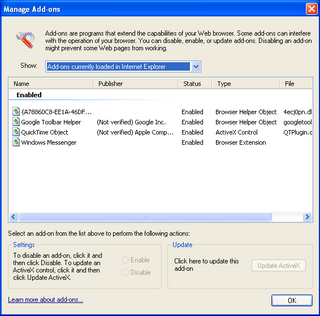Related Research Articles
Malware is any software intentionally designed to cause disruption to a computer, server, client, or computer network, leak private information, gain unauthorized access to information or systems, deprive access to information, or which unknowingly interferes with the user's computer security and privacy. Researchers tend to classify malware into one or more sub-types.

Antivirus software, also known as anti-malware, is a computer program used to prevent, detect, and remove malware.

A Browser Helper Object (BHO) is a DLL module designed as a plugin for the Microsoft Internet Explorer web browser to provide added functionality. BHOs were introduced in October 1997 with the release of version 4 of Internet Explorer. Most BHOs are loaded once by each new instance of Internet Explorer. However, in the case of Windows Explorer, a new instance is launched for each window.
Norton AntiVirus is an anti-virus or anti-malware software product founded by Peter Norton, developed and distributed by Symantec since 1990 as part of its Norton family of computer security products. It uses signatures and heuristics to identify viruses. Other features included in it are e-mail spam filtering and phishing protection.

Winlogon is the component of Microsoft Windows operating systems that is responsible for handling the secure attention sequence, loading the user profile on logon, creates the desktops for the window station, and optionally locking the computer when a screensaver is running. In Windows Vista and later operating systems, the roles and responsibilities of Winlogon have changed significantly.

WinFixer was a family of scareware rogue security programs developed by Winsoftware which claimed to repair computer system problems on Microsoft Windows computers if a user purchased the full version of the software. The software was mainly installed without the user's consent. McAfee claimed that "the primary function of the free version appears to be to alarm the user into paying for registration, at least partially based on false or erroneous detections." The program prompted the user to purchase a paid copy of the program.
Rogue security software is a form of malicious software and internet fraud that misleads users into believing there is a virus on their computer and aims to convince them to pay for a fake malware removal tool that actually installs malware on their computer. It is a form of scareware that manipulates users through fear, and a form of ransomware. Rogue security software has been a serious security threat in desktop computing since 2008. An early example that gained infamy was SpySheriff and its clones, such as Nava Shield.

SpySheriff is malware that disguises itself as anti-spyware software. It attempts to mislead the user with false security alerts, threatening them into buying the program. Like other rogue antiviruses, after producing a list of false threats, it prompts the user to pay to remove them. The software is particularly difficult to remove, since it nests its components in System Restore folders, and also blocks some system management tools. However, SpySheriff can be removed by an experienced user, antivirus software, or by using a rescue disk.

HitmanPro is a portable antimalware program, which aims to detect and remove malicious files and registry entries related to rootkits, trojans, viruses, worms, spyware, adware, rogue antivirus programs, ransomware, and other malware from infected computers.
The Zlob Trojan, identified by some antiviruses as Trojan.Zlob, is a Trojan horse which masquerades as a required video codec in the form of ActiveX. It was first detected in late 2005, but only started gaining attention in mid-2006.
VirusHeat is malware that disguises itself as a legitimate anti-virus program. VirusHeat tricks users into buying the full version of the program through repeated false alerts and popups, purporting to alert the user that there is a system error or they are infected, and must buy the full version to remove. It was launched on February 8, 2008.
MonaRonaDona is a browser hijacker that uses unique tactics through popups or alert messages stating that you are infected with a virus. It uses this message to send users on a hunt for a MonaRonaDona remedy only to run into other malicious websites.

Dr.Web is a software suite developed by Russian anti-malware company Doctor Web. First released in 1992, it became the first anti-virus service in Russia.
MS Antivirus is a scareware rogue anti-virus which purports to remove virus infections found on a computer running Microsoft Windows. It attempts to scam the user into purchasing a "full version" of the software. The company and the individuals behind Bakasoftware operated under other different 'company' names, including Innovagest2000, Innovative Marketing Ukraine, Pandora Software, LocusSoftware, etc.
AV Security Suite is a type of rogue security software, commonly categorized as scareware and malware, which masquerades as a legitimate virus scanner on the victim's Microsoft Windows system. While it is predominantly observed on Windows platforms, it may adopt alternative names on other operating systems to better integrate itself within their interfaces, thereby enhancing its deceptive nature. In the task manager, the program typically appears as a series of seemingly random characters followed by identifiers such as "tssd.exe" or "shdw.exe," a tactic aimed at complicating detection and removal efforts.
PUM.bad.proxy is a form of malware known as a "registry hack", an unauthorized alteration to the Windows Registry file that specifically redirects LAN settings within Internet Explorer, the popular web browser commonly installed as the default web browser for Microsoft Windows. First spotted by users of Malwarebytes' Anti-Malware security software on 22 January 2011, it was reported to Malwarebytes Software over 200 times the first day alone.
Sality is the classification for a family of malicious software (malware), which infects Microsoft Windows systems files. Sality was first discovered in 2003 and has advanced to become a dynamic, enduring and full-featured form of malicious code. Systems infected with Sality may communicate over a peer-to-peer (P2P) network to form a botnet to relay spam, proxying of communications, exfiltrating sensitive data, compromising web servers and/or coordinating distributed computing tasks to process intensive tasks. Since 2010, certain variants of Sality have also incorporated rootkit functions as part of an ongoing evolution of the malware family. Because of its continued development and capabilities, Sality is considered one of the most complex and formidable forms of malware to date.
Win32/Patched is a computer Trojan targeting the Microsoft Windows operating system that was first detected in October 2008. Files detected as "Trojan.Win32.Patched" are usually Windows components that are patched by a malicious application. The purpose of patching varies. For example, certain malware patches system components in order to disable security, such as the Windows Safe File Check feature. Other malware can add parts of its code to a system component and then patch certain functions of the original file to point to an appended code.

Trojan:Win32/FakeSysdef, originally dispersed as an application called "HDD Defragmenter" hence the name "FakeSysdef" or "Fake System Defragmenter", is a Trojan targeting the Microsoft Windows operating system that was first documented in late 2010.
A potentially unwanted program (PUP) or potentially unwanted application (PUA) is software that a user may perceive as unwanted or unnecessary. It is used as a subjective tagging criterion by security and parental control products. Such software may use an implementation that can compromise privacy or weaken the computer's security. Companies often bundle a wanted program download with a wrapper application and may offer to install an unwanted application, and in some cases without providing a clear opt-out method. Antivirus companies define the software bundled as potentially unwanted programs which can include software that displays intrusive advertising (adware), or tracks the user's Internet usage to sell information to advertisers (spyware), injects its own advertising into web pages that a user looks at, or uses premium SMS services to rack up charges for the user. A growing number of open-source software projects have expressed dismay at third-party websites wrapping their downloads with unwanted bundles, without the project's knowledge or consent. Nearly every third-party free download site bundles their downloads with potentially unwanted software. The practice is widely considered unethical because it violates the security interests of users without their informed consent. Some unwanted software bundles install a root certificate on a user's device, which allows hackers to intercept private data such as banking details, without a browser giving security warnings. The United States Department of Homeland Security has advised removing an insecure root certificate, because they make computers vulnerable to serious cyberattacks. Software developers and security experts recommend that people always download the latest version from the official project website, or a trusted package manager or app store.
References
- ↑ "FireEye Event Description: Trojan.Vundo".
- 1 2 Bell, Henry; Chien, Eric (March 17, 2010). "Trojan.Vundo". Symantec Security Response. Symantec. Archived from the original on December 13, 2006. Retrieved March 14, 2012.
- ↑ SuperMWindow - A New Vundo.